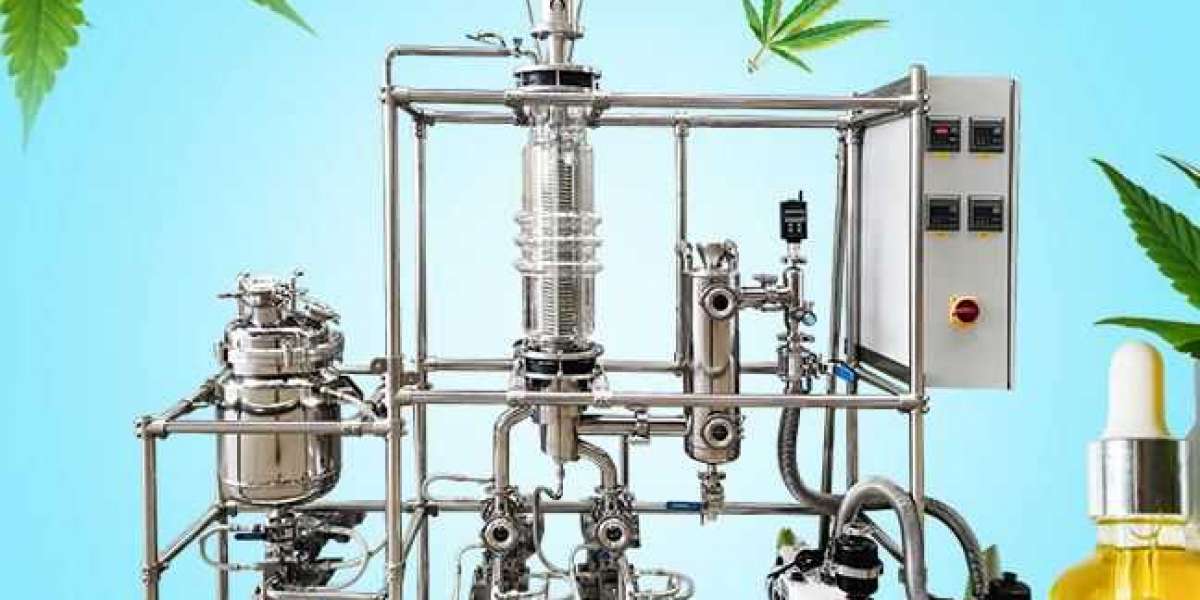Original title: Summary of Basic Knowledge of Rotary Evaporator Rotary evaporator, also known as rotary evaporator, is a common laboratory equipment composed of motor, distillation flask, heating pot, condenser tube and other parts. Today we will give the laboratory Xiaobai a literacy post, including the principle, background, maintenance and purchase. Basic structure and principle: The distilling flask is a eggplant-shaped or round-bottomed flask with a standard ground joint, and is connected with a pressure reducing pump through a highly refluxing serpentine condensing tube, and the other opening of the refluxing condensing tube is connected with a receiving flask with a ground joint for receiving the evaporated organic solvent. A three-way piston is arranged between the condenser tube and the pressure reducing pump, when the system is communicated with the atmosphere, the distillation flask and the liquid receiving flask can be taken down to transfer the solvent, and when the system is communicated with the pressure reducing pump, the system should be in a pressure reducing state. When using, the pressure should be reduced first, and then the motor should be started to rotate the distillation flask. At the end, the machine should be stopped first, and then the atmosphere should be opened to prevent the distillation flask from falling off during rotation. As a heat source for distillation, it is often equipped with a corresponding thermostatic water tank. By electronic control, the flask is rotated at a constant speed at the most suitable speed to increase the evaporation area. The evaporation flask was brought to a negative pressure state by a vacuum pump. And that evaporation flask is place in a water bath for constant temperature heat while rotating, and the solution in the flask is heated, diffused and evaporate in the rotating flask under negative pressure. The rotary evaporator system can be sealed and decompressed to 400 to 600 mm Hg; the solvent in the distillation flask is heated by a heating bath, and the heating temperature can be close to the boiling point of the solvent; at the same time, the rotary evaporator system can rotate at a speed of 50 to 160 revolutions per minute, so that the solvent forms a film and the evaporation area is increased. In addition, under the action of the high-efficiency cooler, the hot steam can be quickly liquefied and the evaporation rate can be accelerated. I. Development history of rotary evaporator The development history of rotary evaporator is as follows: 1. Wool condenser Ancient Greek sailors noticed the condensation of mist droplets on the sails, and sailors put wool over a heated pot to obtain fresh water, which was later called wool condenser. 2. The study of Aristotle In 350 BC in ancient Greece, Aristotle studied the principles of distillation and condensation, and discovered the important law of water circulation in nature. "By distilling water into steam and then into liquid, sea water can be turned into drinkable water.". 3. The study of alchemists In the 2nd century AD, alchemists developed the earliest copper distillation device, the "distillation pot". 4. Appearance of vacuum distillation In the 17th century, Robert Boyle, an Irish physicist,wiped film distillation, carried out the first revolutionary vacuum distillation, which proved the relationship between pressure and boiling point, and the distillation speed was greatly improved. 5. Rotating distillation flask and commercial rotary evaporator In the 1950s, scientists C. C. Draig and M. E. Volk proposed the concept of rotating flask to achieve better mixing and larger area heating of samples. At the same time, the earliest commercial rotary evaporator was born. 6. The Age of Intelligent Rotary Steaming Expand the full text In the 21st century, the wave of artificial intelligence has swept the world. With the continuous advancement of laboratory automation, intelligent rotary steaming has become the standard of modern laboratories. II. Maintenance knowledge of rotary evaporator 1. Check the instrument carefully before use. ? Check whether the glass bottle is damaged and whether the interfaces are matched. Handle with care. 2. Use a soft cloth Wipe each interface (napkin can be used instead), and then apply a little vacuum grease. Vacuum grease must be covered after use to prevent dust and sand from entering. 3. Do not tighten the connectors too tightly. ? Regularly loosen and activate the collaterals to avoid seizure of the connector due to long-term locking. 4. Turn on the power switch first ? Then let the machine run from slow to fast. When the machine is stopped, the machine should be in a stop state, and then turn off the switch. 5. Do not over tighten the Teflon switches everywhere ? Easy to damage the glass. 6. After each use, all kinds of oil stains left on the surface of the machine must be wiped with a soft cloth. ? Stains, solvent residue, keep clean. 7. Loosen each Teflon switch after shutdown ? The PTFE piston will be deformed if it is still in the working state for a long time. 8. Clean the sealing ring regularly. ? Method: Take down the seal ring,hemp extraction centrifuge, check whether there is dirt on the shaft, wipe it clean with a soft cloth, then apply a little vacuum grease, and reinstall it to keep the shaft and seal ring smooth. 9. Water must not enter the electrical part. ? Moisture is strictly prohibited. 3. How to choose a rotary evaporator Before choosing a rotary evaporator, it is necessary to clarify some questions, such as how much is distilled at a time, how many samples need to be distilled every day, what solvents are expected to be distilled, what is the boiling point range of solvents, and whether these solvents are flammable, explosive or toxic and harmful. After determining the experimental requirements and the type of solvent to be distilled, the rotary evaporator can be purchased. 1. Define the specifications of the rotary evaporator The specifications of the rotary evaporator are usually distinguished by the volume of the evaporation bottle. The size of the required evaporation bottle depends on the amount of material to be evaporated. Generally speaking, 2L, 3L and 5L rotary evaporators are suitable for laboratory small-scale tests; 5L, 10L and 20L are suitable for pilot tests; 20L and 50L are suitable for pilot tests and production. Of course, under special circumstances, the volume of the evaporation bottle can also be expanded with the help of the continuous feed pipe, thus expanding the amount of continuous distillation to a certain extent. 2. Identify the distillation tasks to be performed on the rotary evaporator 2.1 Distillation efficiency The distillation efficiency of the rotary evaporator determines the number of samples that can be distilled per day. In the case of the same solvent, the higher the distillation efficiency, the more samples can be distilled. If the sample quantity is large, more attention should be paid to the distillation efficiency when choosing the rotary evaporator. 2.2 Safety risk assessment The safety risk of distillation mainly comes from the solvent and heating medium of distillation. 1) If the heating medium is silicone oil, the ignition point shall be at least 25 ° C higher than the maximum temperature of the heating pot. 2) If the distillation solvent is flammable and explosive, explosion-proof glass components can be the first choice. After distillation, it is best if the instrument can automatically deflate, so as to avoid explosion caused by too fast manual deflation. 3) To optimize the laboratory environment, rotary vacuum evaporator ,cbd crystallization equipment, a secondary condensation device can be selected to maximize the recovery of distillation solvent. 4. Advantages of rotary evaporator: 1. All rotary evaporators have a built-in lift motor. ? The device can automatically lift the flask to the position above the heating pot when the power is off. 2. Due to the centripetal force and friction between the liquid sample and the evaporation bottle, The liquid sample forms a layer of liquid film on the inner surface of the evaporation bottle, and the heating area is large; 3. The force generated by the rotation of the sample effectively inhibits the boiling of the sample. 。 These features, together with their convenience, allow modern rotary evaporators to be used to distill most samples quickly and gently, even by inexperienced operators. 5. Disadvantages of rotary evaporator: Boiling of certain samples, such as ethanol and water, will result in the loss of the sample collected by the experimenter. During operation, boiling can usually be prevented by carefully adjusting the working intensity of the vacuum pump or the temperature of the heating pot during the mixing stage of the distillation process. Alternatively, anti-boil particles may be adde to that sample. For samples that are particularly difficult to distill, including those that are prone to foaming, the rotary evaporator can also be equipped with a special condenser tube. 6. What are the precautions for the use of the rotary evaporator? If the rotary evaporator is used improperly, it is easy to cause damage to the equipment, so some matters should be paid attention to in the use process, as follows: 1. Glass parts shall be handled with care, and shall be washed, wiped or dried before installation. 2. A layer of vacuum grease shall be applied to each ground opening, sealing surface, sealing ring and joint before installation. 3. Water must be added before the heating tank is powered on, and dry heating without water is not allowed. 4. RE-52 B must be screwed into the safety hole to avoid damaging the flask. 5. If the vacuum cannot be pumped up, check: (1) Whether the joints and interfaces are sealed (2) Whether the seal ring and sealing surface are effective (3) Whether the vacuum grease between the main shaft and the seal ring is properly applied (4) Whether the vacuum pump and its hose are leaking. (5) Whether the glass is cracked, broken or damaged. 6. About vacuum degree Vacuum degree is the most important process parameter of rotary evaporator, but users often encounter the problem that the vacuum degree can not be reached. This is often related to the nature of the solvent used. Water, ethanol, acetic acid, petroleum ether, chloroform and other solvents are commonly used in biochemical and pharmaceutical industries. However, general vacuum pumps can not resist strong organic solvents. Special vacuum pumps with strong corrosion resistance can be used. Water circulation vacuum pumps are recommended. The method to check whether the instrument is leaking: clip off the external vacuum hose one by one, and observe whether the vacuum meter on the instrument can keep no leakage for five minutes. If there is air leakage, check whether the sealing ring on each sealing joint and rotating shaft is effective. On the contrary, if the instrument is normal, the vacuum pump and vacuum pipeline should be checked. 7. About motor temperature rise If a certain type of motor is a three-phase, 220V special motor with Class E insulation, and the winding is made of polyester high-strength enameled wire, it is normal that the surface temperature rise (the difference between the surface temperature of the motor and the ambient temperature) of the motor does not exceed 45 ℃ when it is used continuously at an altitude of not more than 1000 meters and at an ambient temperature of not more than 40 ℃. If the temperature rise exceeds 45 ℃, the relevant transmission lubrication system should be checked. 7. What are the factors affecting the distillation efficiency of the rotary evaporator? The distillation efficiency of the rotary evaporator determines the number of samples that can be distilled per day. In the case of the same solvent, the higher the distillation efficiency, the more samples can be distilled. So what are the factors that affect the distillation efficiency of rotary evaporator? 1. Vacuum value of system The closed space of the rotary evaporator is composed of glass components such as an evaporation bottle, an evaporation tube, a seal ring, a condenser tube, a vacuum buffer bottle, a vacuum pump and a vacuum pipeline, among which the vacuum pump, the seal ring and the vacuum tube are the most critical and changeable factors affecting the vacuum of the system. Vacuum pump and vacuum controller: The lower the vacuum pump limit, the lower the vacuum value of the system. When distilling, it is necessary to set a reasonable vacuum value through the vacuum controller to ensure the distillation efficiency and avoid bumping. At present, the ultimate vacuum of the diaphragm vacuum pump can be as low as 2mbar, and the ultimate vacuum of the circulating water pump is about 50mbar (0.095 kPa). If the budget allows, a vacuum controller or vacuum valve is necessary to control the system vacuum level required for distillation. Sealing ring: As the key sealing element to receive the evaporation tube and condenser tube, its wear resistance and corrosion resistance are the key. Materials commonly used for sealing rings are PTFE and rubber. Obviously, PTFE has better wear resistance and corrosion resistance. Some manufacturers add stainless steel buffer shrapnel in the seal ring, which has better wear resistance. Vacuum tube material: general manufacturers do not have standard vacuum tubes, when choosing and purchasing by themselves, silicone tubes are naturally the first choice, because their aging efficiency is slower than rubber tubes. 2. Heating pot temperature The higher the temperature of the heating pot, the faster the distillation effect of the solvent, but considering the thermal sensitivity of the target component and the safety of operation, the most commonly used temperature is 60 C. Moreover, above 80 ° C, the use of silicone oil as a medium will cause cleaning problems, and it is generally recommended to reduce the vacuum value to achieve faster distillation efficiency. At present, the best diaphragm vacuum pump on the market has a limit vacuum of 2mbar, and DMF can be distilled at room temperature. 3. Rotating speed of evaporation bottle The faster the rotating speed of the evaporation bottle is, the larger the wetting area of the inner surface of the bottle is, and the larger the heated area is; but at the same time, the thicker the liquid film is, and the greater the heat transfer temperature difference is. There is an optimum rotational speed for materials with different viscosities. And that rotation pow is provided by the motor, the DC brushless motor, the AC motor and the step motor are all available on the market, and the feedback of the DC brushless motor is the best, and the motor is maintenance-free for 10 years. 4. Temperature of cooling medium In order to ensure the best distillation efficiency, it is generally recommended to maintain a temperature difference of 40 ° C between the cooling medium and the heating pot temperature, so as to condense the hot steam quickly and reduce the influence of the steam on the vacuum of the system. 8. The biggest drawback in the application of rotary evaporator It is the boiling of certain samples, such as ethanol and water, that will result in the loss of the sample collected by the experimenter. During operation, boiling can usually be prevented by carefully adjusting the working intensity of the vacuum pump or the temperature of the heating pot during the mixing stage of the distillation process. Alternatively, anti-boil particles may be adde to that sample. For samples that are particularly difficult to distill, including those that are prone to foaming,50l rotovap, the rotary evaporator can also be equipped with a special condenser tube. The article originates from dandelion, the author catches a cold every year, and reprints only to share knowledge. Would like to help you! Return to Sohu to see more Responsible Editor:. toptiontech.com
KathleenJHarr
8 Blog indlæg


